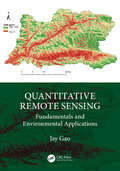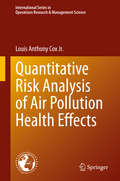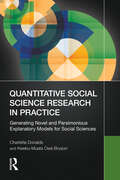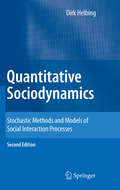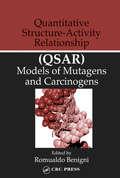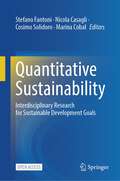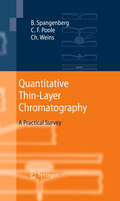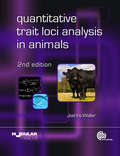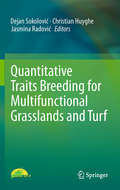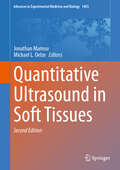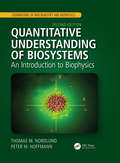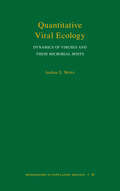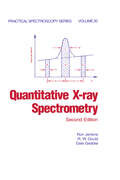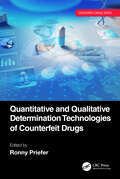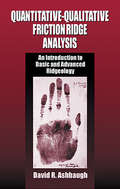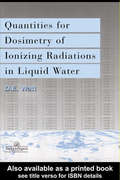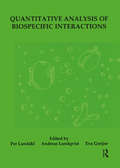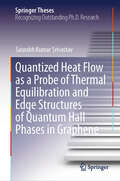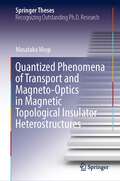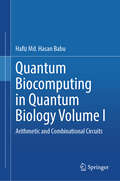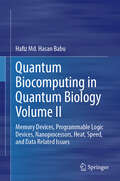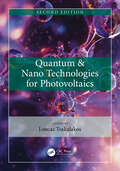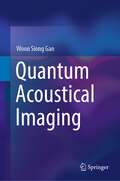- Table View
- List View
Quantitative Remote Sensing: Fundamentals and Environmental Applications
by Jay GaoThis book provides comprehensive and in-depth explanations of all topics related to quantitative remote sensing and its applications in terrestrial, biospheric, hydrospheric, and atmospheric studies. It elucidates how to retrieve quantitative information on a wide range of environmental parameters from various remote sensing data at the highest accuracy possible and expounds how different aspects of the target of remote sensing can be quantified using diverse analytical methods and level of accuracy. Written in an easy-to-follow language, logically organized, and with step-by-step examples, the book assists readers to deepen their understanding of the theory and cutting-edge research on quantitative remote sensing. Features Explains how to retrieve quantitative information on a wide range of environmental parameters from various tailored remote sensing data at the highest accuracy possible. Manifests the author's decades of teaching and research in quantitative remote sensing and approaches the subject from both theoretical and pragmatic perspectives, informed by the latest research outcomes. Includes practical and real-life examples to illustrate how the quantitative information on a target can be retrieved from a given type of remote sensing data. Focuses on the latest developments in the field of quantitative remote sensing. Introduces sufficient mathematical concepts to reveal how remotely sensed data are converted to quantitative information while providing quality assurance of the retrieved results. This is a suitable textbook for upper-level undergraduate or postgraduate students and serves as a handy and valuable reference for professionals working in monitoring the environment. By reading this book, readers gain a sound understanding of how to retrieve quantitative information on the environment from diverse remote sensing data using the most appropriate cutting-edge methods and software.
Quantitative Research Methods For Professionals
by W. Paul VogotQuantitative Research Methods For Professionals by W. Paul Vogot Custom Edition for Capella University
Quantitative Risk Analysis of Air Pollution Health Effects (International Series in Operations Research & Management Science #299)
by Louis Anthony Cox Jr.This book highlights quantitative risk assessment and modeling methods for assessing health risks caused by air pollution, as well as characterizing and communicating remaining uncertainties. It shows how to apply modern data science, artificial intelligence and machine learning, causal analytics, mathematical modeling, and risk analysis to better quantify human health risks caused by environmental and occupational exposures to air pollutants. The adverse health effects that are caused by air pollution, and preventable by reducing it, instead of merely being statistically associated with exposure to air pollution (and with other many conditions, from cold weather to low income) have proved to be difficult to quantify with high precision and confidence, largely because correlation is not causation. This book shows how to use recent advances in causal analytics and risk analysis to determine more accurately how reducing exposures affects human health risks. Quantitative Risk Analysis of Air Pollution Health Effects is divided into three parts. Part I focuses mainly on quantitative simulation modelling of biological responses to exposures and resulting health risks. It considers occupational risks from asbestos and crystalline silica as examples, showing how dynamic simulation models can provide insights into more effective policies for protecting worker health. Part II examines limitations of regression models and the potential to instead apply machine learning, causal analysis, and Bayesian network learning methods for more accurate quantitative risk assessment, with applications to occupational risks from inhalation exposures. Finally, Part III examines applications to public health risks from air pollution, especially fine particulate matter (PM2.5) air pollution. The book applies freely available browser analytics software and data sets that allow readers to download data and carry out many of the analyses described, in addition to applying the techniques discussed to their own data.http://cox-associates.com:8899/
Quantitative Risk Assessment for Environmental and Occupational Health
by William H. HallenbeckQuantitative Risk Assessment for Environmental and Occupational Health, Second Edition features twice as many risk analysis models with complete examples as the previous edition. The book features new information in the following areas:Calculation of human dose rate and dose from experimental studies (animal and human) Quantitat
Quantitative Social Science Research in Practice: Generating Novel and Parsimonious Explanatory Models for Social Sciences
by Kweku-Muata Osei-Bryson Charlette DonaldsQuantitative Social Science Research in Practice: Generating Novel and Parsimonious Explanatory Models for Social Sciences examines quantitative Behavioral Science Research (BSR) by focusing on four key areas:Developing Novel, Parsimonious, and Actionable Causal Models: Researchers often face challenges in creating new, parsimonious causal models supported by empirical evaluation. A promising approach involves using meta-analytic reviews and more recent studies to identify relevant constructs and hypotheses that would constitutethe new causal model.Exploring the Scope of Context for a Novel Causal Model: The relevance of causal models may vary based on context, such as national or organizational culture, economic and political situations, and feasibility constraints. Behavioural science researchers have struggled to balance rigor and relevance, as theories effective in one context may not be valid in another. This book presents an approach to determine the contextual scope for new causal models.Guidance to Practice from a Novel Causal Model: Quantitative BSR studies should offer practical guidance, but often this guidance is vague or superficial. This book proposes an approach to highlight actionable insights derived from data analysis of new causal models, ensuring that the research offers concrete guidance for practitioners.Implementing Guidance from Causal Models: A significant limitation of BSR studies is the lack of clarity on how results can be made actionable for decision-makers, considering the costs and benefits of actions. This book presents a method to make research results actionable, especially for models with high explanatory and predictive power.The book is designed to be useful for various audiences: Business Managers and Practitioners: Those conducting or utilizing quantitative BSR for decision-making can find practical approaches for developing and applying causal models. Master’s and PhD Students: Students across disciplines interested in quantitative BSR can gain insight into novel methods for creating strong causal models. Active Scholars: Researchers aiming to apply new approaches in their work can benefit from the strategies outlined. Professors and Instructors: Those teaching research methodology or supervising theses can find the book a valuable resource for guiding students in their research projects. The book aims to advance the field of quantitative BSR by providing robust methodologies for developing, contextualizing, and implementing causal models, ensuring both academic rigor and practical relevance.
Quantitative Sociodynamics
by Dirk HelbingThis new edition of Quantitative Sociodynamics presents a general strategy for interdisciplinary model building and its application to a quantitative description of behavioral changes based on social interaction processes. Originally, the crucial methods for the modeling of complex systems (stochastic methods and nonlinear dynamics) were developed in physics and mathematics, but they have very often proven their explanatory power in chemistry, biology, economics and the social sciences as well. Quantitative Sociodynamics provides a unified and comprehensive overview of the different stochastic methods, their interrelations and properties. In addition, it introduces important concepts from nonlinear dynamics (e.g. synergetics, chaos theory). The applicability of these fascinating concepts to social phenomena is carefully discussed. By incorporating decision-theoretical approaches, a fundamental dynamic model is obtained, which opens new perspectives in the social sciences. It includes many established models as special cases, e.g. the logistic equation, the gravity model, some diffusion models, evolutionary game theory and social field theory. Moreover, it implies numerous new results and is relevant for various application areas, such as opinion formation, migration, the self-organization of behavioral conventions, and the behavior of customers and voters. Theoretical results are complemented and illustrated by numerous computer simulations. Quantitative Sociodynamics is relevant both for social scientists and natural scientists who are interested in the application of stochastic and synergetics concepts to interdisciplinary topics.
Quantitative Structure-Activity Relationship (QSAR) Models of Mutagens and Carcinogens
by Romualdo BenigniApplied with success in a number of areas, QSAR studies have become particularly popular in the rational design of drugs and pesticides. Much has been published on the principles of QSAR in this area, but not on their application s to toxic chemicals. This book provides the first comprehensive, interdisciplinary presentation of QSAR studies on
Quantitative Sustainability: Interdisciplinary Research for Sustainable Development Goals
by Nicola Casagli Stefano Fantoni Cosimo Solidoro Marina CobalThis open access book focuses on how scientific methodologies can help industrial managers, entrepreneurs and policymakers handle the 17 Sustainable Development Goals in an efficient and realistic way. It also offers an operative scheme for scientists to overcome their discipline barriers. Is interdisciplinarity an intrinsic research value or is it merely instrumental for handling the increasing flux of open problems that sustainability poses to science?Can these problems of sustainability be solved with what the authors already know? Is it just a matter of having the right people at the table and giving them sufficient resources, or is it something more? Is meeting the needs of the present without compromising those of future generations a scientific definition of sustainable development? Questions similar to those posed in the sixties regarding complexity must be asked about sustainability today. In addition, the new data science includes powerful tools for making novel quantitative predictions about future sustainability indicators, an open problem that the book discusses. This book is primarily addressed to Ph.D. students, postdocs and senior researchers in the Life and Hard Science (LHS) and Social Sciences and Humanities (SSH) disciplines, as well as professionals of the primary, secondary and tertiary industrial sectors.
Quantitative Thin-Layer Chromatography
by Bernd Spangenberg Colin F. Poole Christel WeinsThin-layer chromatography (TLC) is widely used particularly for pharmaceutical and food analysis. While there are a number of books on the qualitative identification of chemical substances by TLC, the unique focus here is on quantitative analysis. The authors describe all steps of the analytical procedure, beginning with the basics and equipment for quantitative TLC followed by sample pretreatment and sample application, development and staining, scanning, and finally statistical and chemometric data evaluation and validation. An important feature is the coverage of effect-directed biological detection methods. Chapters are organized in a modular fashion facilitating the easy location of information about individual procedural steps.
Quantitative Trait Loci Analysis in Animals
by Joel WellerQuantitative Trait Loci (QTL) is a topic of major agricultural significance for efficient livestock production. This advanced-level textbook covers all the statistical methods that have been used or proposed for detection and analysis of QTL and marker- and gene- assisted selection in animal genetics and breeding, as well as new advances that have revolutionized the field since the first edition.
Quantitative Traits Breeding for Multifunctional Grasslands and Turf
by Dejan Sokolović Christian Huyghe Jasmina RadovićGrasslands are among the largest ecosystems in the world and consequently are of great importance to mankind. The genotypes of the species which are the main components of the grasslands have great influence on total outcome and successful utilization of grasslands. Therefore fodder crops and turf swards should be constantly improved to follow modern trends in agriculture production and landscape architecture. The wide range of breeding programs for forage and amenity species, as well as new breeding methods and techniques, is rapidly expanding the boundaries and is making it possible to achieve outstanding breeding results. This book includes papers presented at the 30th EUCARPIA Fodder Crops and Amenity Grasses Section Meeting. The challenging title of the book focuses on breeding of quantitative traits, which directly impact the profitability and sustainability of grasslands and fodder crops production, as well as on multidisciplinary approach in grassland research and utilisation. Included papers offer a unique collection of ideas and breakthroughs in the fields of fodder crops and amenity grasses breeding and genetics, as well as in the creative and innovative application of new tools in practical breeding.
Quantitative Ultrasound in Soft Tissues (Advances in Experimental Medicine and Biology #1403)
by Jonathan Mamou Michael L. OelzeQuantitative ultrasound (QUS) continues to mature as a research field and is primed to make a swift transition to routine preclinical and clinical applications. This book will serve two main purposes: Advanced education in QUS by providing a complete and thorough review of all theoretical, physical, and engineering aspects of QUS.Review of recent development of QUS by lead contributors in the research field. This 2nd edition will focus on 6 modern research topics related to quantitative ultrasound of soft tissues: Spectral-based methods for tissue characterization, tissue typing, cancer detection, etc.Attenuation estimation for tissue characterization and improving spectral based methodsEnvelope statistics analysis as a means of quantifying and imaging tissue properties.Ultrasound computed tomography for preclinical and clinical imaging.Scanning acoustic microscopy for forming images of mechanical properties of soft tissues with micron resolution.Phantoms for quantitative ultrasound.
Quantitative Understanding of Biosystems: An Introduction to Biophysics, Second Edition (Foundations of Biochemistry and Biophysics)
by Peter M. Hoffmann Thomas M. NordlundPraise for the prior edition "The author has done a magnificent job… this book is highly recommended for introducing biophysics to the motivated and curious undergraduate student."―Contemporary Physics "a terrific text … will enable students to understand the significance of biological parameters through quantitative examples―a modern way of learning biophysics." ―American Journal of Physics "A superb pedagogical textbook… Full-color illustrations aid students in their understanding" ―Midwest Book Review This new edition provides a complete update to the most accessible yet thorough introduction to the physical and quantitative aspects of biological systems and processes involving macromolecules, subcellular structures, and whole cells. It includes two brand new chapters covering experimental techniques, especially atomic force microscopy, complementing the updated coverage of mathematical and computational tools. The authors have also incorporated additions to the multimedia component of video clips and animations, as well as interactive diagrams and graphs. Key Features: Illustrates biological examples with estimates and calculations of biophysical parameters. Features two brand-new chapters on experimental methods, a general overview and focused introduction to atomic force microscopy. Includes new coverage of important topics such as measures of DNA twist, images of nanoparticle assembly, and novel optical and electron nanoscopy. Provides a guide to investigating current expert biophysical research. Enhanced self-study problems and an updated glossary of terms.
Quantitative Viral Ecology
by Joshua S. WeitzWhen we think about viruses we tend to consider ones that afflict humans--such as those that cause influenza, HIV, and Ebola. Yet, vastly more viruses infect single-celled microbes. Diverse and abundant, microbes and the viruses that infect them are found in oceans, lakes, plants, soil, and animal-associated microbiomes. Taking a vital look at the "microscopic" mode of disease dynamics, Quantitative Viral Ecology establishes a theoretical foundation from which to model and predict the ecological and evolutionary dynamics that result from the interaction between viruses and their microbial hosts. Joshua Weitz addresses three major questions: What are viruses of microbes and what do they do to their hosts? How do interactions of a single virus-host pair affect the number and traits of hosts and virus populations? How do virus-host dynamics emerge in natural environments when interactions take place between many viruses and many hosts? Emphasizing how theory and models can provide answers, Weitz offers a cohesive framework for tackling new challenges in the study of viruses and microbes and how they are connected to ecological processes--from the laboratory to the Earth system.Quantitative Viral Ecology is an innovative exploration of the influence of viruses in our complex natural world.
Quantitative X-Ray Spectrometry (Practical Spectroscopy)
by Ron JenkinsThis work covers important aspects of X-ray spectrometry, from basic principles to the selection of instrument parameters and sample preparation. This edition explicates the use of combined X-ray fluorescence and X-ray diffraction data, and features new applications in environmental studies, forensic science, archeometry and the analysis of metals
Quantitative and Qualitative Determination Technologies of Counterfeit Drugs (Counterfeit Drugs Series)
by Ronny PrieferDrugs are often counterfeited to reduce manufacture costs, while still marketing it at as an authentic product. Increased incidence of drug counterfeiting is most noticeable in developing countries, which may not have the resources to supply counterfeit detection devices on a large scale. It is important to consider the problems caused and to propose options for controlling and reducing the prevalence of counterfeit medications. Various technologies are needed to identify the chemical properties of a questioned medicinal product, which can then be used to determine its authenticity. This volume focuses on current technological approaches that are able to detect counterfeited pharmaceuticals. Features • Focuses on current technological approaches that are able to detect counterfeited pharmaceuticals. • Assesses the chemical methods of identifying counterfeit medicinal products and explains the theoretical underpinnings of the methods. • Provides case study type examples of the application for analysis of suspected counterfeit pharmaceuticals. • Discusses the detection and analysis of counterfeit drugs, and appropriate tools for combating this issue. • The editor draws on his experience as a respected chemist and prolific author in the field to provide this unique text on drug counterfeiting detection.
Quantitative-Qualitative Friction Ridge Analysis: An Introduction to Basic and Advanced Ridgeology (ISSN)
by David R. AshbaughThe science of fingerprint identification isn‘t always cut and dry. This book examines the latest methods and techniques in the science of friction ridge identification, or ridgeology. The author examines every facet of the discipline, from the history of friction ridge identification to the scientific basis and the various steps of the identification process. The book, which features several detailed illustrations and photographs, also includes a new method for Palmar Flexion Crease Identification (palm lines) designed by the author and which has helped solve several criminal cases where fingerprints were not available.
Quantities For Generalized Dosimetry Of Ionizing Radiations in Liquid Water
by D E WattIntended as a reference handbook of quantities used in dosimetry of ionizing radiations. Fields of application are radiological protection, environmental radiation, health physics, nuclear medicine and radiotherapy, radiobiology, radiopharmacy and radiation chemistry. The book is in three parts. The first part deals with electrons, X-rays and gamma
Quantitive Analysis Of Biospec
by Per Lundahl; Andreas Lundqvist; Eva GreijerFirst published in 2004, this book collects several up-to-date methods for quantitative analysis of biospecific interactions, a field that has a long history that perhaps can be said to have begun with the classical paper of G. Scatchard in 1949 (The attractions of proteins for small molecules and ions, but which has advanced impressively during the last few years. A precise spatial arrangement of just a few hydrogen bonds can confer a remarkably specific reversible association between two molecules. A web of weak interactions governs biospecific recognition in general. The binding equilibria in living cells tune and coordinate a multitude of functions. The thermodynamic properties of such interactions are often studied by binding experiments in simplified and essentially ideal systems. However, similar types of studies may elucidate the biologically relevant dynamic steady-state conditions in living cells and organisms, allowing for the very wide range of interactant concentrations and the interplay between the many reactions and interactions. The development in biosciences will continue with in-depth studies of macromolecules and membranes. More detailed knowledge will allow analyses of delicate balances between substances and events in the complex systems involved in life processes. Methods to study biospecific affinities are thus highly important tools for understanding mechanisms and effects of molecular binding events in vivo and in vitro, e.g., in biochemical, biomedical and pharmaceutical research, and for biotechnological research and production.
Quantized Heat Flow as a Probe of Thermal Equilibration and Edge Structures of Quantum Hall Phases in Graphene (Springer Theses)
by Saurabh Kumar SrivastavThis book describes the quantized thermal conductance measurements of integer and several fractional quantum Hall (QH) states realized in graphene devices. Although the electrical conductance quantization of the QH effect in graphene was demonstrated in 2005, a heat flow study of QH states needed to be included. This becomes particularly essential for the hole-conjugate fractional QH phases, where counterpropagating edge modes lead to complex transport behavior. The experimental results reported in this thesis are the first set of experiments done for the quantized heat flow in graphene devices since the first mechanical isolation of graphene flakes. The book devotes two detailed introductory chapters to the electronic properties of the graphene and its bilayer and trilayer parts at zero magnetic fields, and to the essential physics of the integer and fractional quantum Hall (FQH) states, the topological order of FQH phases and the experiments that can detect them. The book has a dedicated chapter for the details of the device fabrication and thermal conductance measurement technique. The rest of the chapters are dedicated to the systematic and detailed documentation of the new experimental findings of quantized heat flow in quantum Hall phases in graphene.
Quantized Phenomena of Transport and Magneto-Optics in Magnetic Topological Insulator Heterostructures (Springer Theses)
by Masataka MogiThis book presents experimental studies on emergent transport and magneto-optical properties in three-dimensional topological insulators with two-dimensional Dirac fermions on their surfaces. Designing magnetic heterostructures utilizing a cutting-edge growth technique (molecular beam epitaxy) stabilizes and manifests new quantization phenomena, as confirmed by low-temperature electrical transport and time-domain terahertz magneto-optical measurements. Starting with a review of the theoretical background and recent experimental advances in topological insulators in terms of a novel magneto-electric coupling, the author subsequently explores their magnetic quantum properties and reveals topological phase transitions between quantum anomalous Hall insulator and trivial insulator phases; a new topological phase (the axion insulator); and a half-integer quantum Hall state associated with the quantum parity anomaly. Furthermore, the author shows how these quantum phases can be significantly stabilized via magnetic modulation doping and proximity coupling with a normal ferromagnetic insulator. These findings provide a basis for future technologies such as ultra-low energy consumption electronic devices and fault-tolerant topological quantum computers.
Quantum Biocomputing in Quantum Biology Volume I: Arithmetic and Combinational Circuits
by Hafiz Md. Hasan BabuThe book starts with the basics of Quantum Computing, Biocomputing, Quantum Biology, Quantum-DNA Computing, and DNA-Quantum Computing. It also discusses the fundamental operations in quantum computing and Biocomputing. Different types of quantum arithmetic circuits, quantum-DNA arithmetic circuits and DNA-quantum arithmetic circuits such as basic and universal gate operations, half-adder, full-adder, half subtractor, full subtractor, N-qubit adders, multipliers, dividers, etc., are explained clearly. Nuclear Magnetic Resonance (NMR), NMR relaxation, quantum cache memory, heat conduction circuit, and trap ion are also discussed. The readers can get a clear idea about different types of quantum, quantum-DNA and DNA-quantum circuits such as arithmetic, combinational, sequential, memory devices, programmable logic devices, nano-processors and will be able to design their own circuits. Then, it discusses Heat Measurement, Speed Calculation, Heat Transfer, Data Conversion, and Data Management in Quantum Computing and Quantum Biocomputing (Quantum-DNA Computing and DNA-Quantum Computing). As a whole, this book is a great resource for quantum, quantum-DNA and DNA-Quantum Computing, it is the book where computing in quantum biology is introduced for the quantum biology researchers, students, and academicians. This is a novel approach to writing a book in this field. This book quenches the thirst of beginners to advanced-level readers.
Quantum Biocomputing in Quantum Biology Volume II: Memory Devices, Programmable Logic Devices, Nanoprocessors, Heat, Speed, and Data Related Issues
by Hafiz Md. Hasan BabuThe book starts with the basics of Quantum Computing, Biocomputing, Quantum Biology, Quantum-DNA Computing, and DNA-Quantum Computing. It also discusses the fundamental operations in quantum computing and Biocomputing. Different types of quantum arithmetic circuits, quantum-DNA arithmetic circuits and DNA-quantum arithmetic circuits such as basic and universal gate operations, half-adder, full-adder, half subtractor, full subtractor, N-qubit adders, multipliers, dividers, etc., are explained clearly. Nuclear Magnetic Resonance (NMR), NMR relaxation, quantum cache memory, heat conduction circuit, and trap ion are also discussed. The readers can get a clear idea about different types of quantum, quantum-DNA and DNA-quantum circuits such as arithmetic, combinational, sequential, memory devices, programmable logic devices, nano-processors and will be able to design their own circuits. Then, it discusses Heat Measurement, Speed Calculation, Heat Transfer, Data Conversion, and Data Management in Quantum Computing and Quantum Biocomputing (Quantum-DNA Computing and DNA-Quantum Computing). As a whole, this book is a great resource for quantum, quantum-DNA and DNA-Quantum Computing, it is the book where computing in quantum biology is introduced for the quantum biology researchers, students, and academicians. This is a novel approach to writing a book in this field. This book quenches the thirst of beginners to advanced-level readers.
Quantum & Nano Technologies for Photovoltaics
by Loucas TsakalakosOngoing concerns regarding greenhouse gas-related environmental effects, energy security, and the rising costs of conventional energy sources has led to sustained interest and growth in solar energy in general, and photovoltaics in particular. Exploring state-of-the-art developments from a practical point of view, Quantum and Nanotechnology for Photovoltaics is the second edition of the book and examines issues in increasing efficiency, decreasing costs, and how these two goals can be achieved in a single photovoltaic device leveraging emergent quantum and nanoscale phenomena.The book provides fundamental background, including new chapters on quantum physics, hot carrier solar cells, luminescent solar concentrators, and additional topics, and places research approaches within the proper physical context as related to photovoltaics performance enhancement. It reviews the applications of devices and their performance requirements, followed by coverage of thin films and advanced band structure concepts for obtaining efficiencies above the Shockley–Queisser single band-gap efficiency limit of 31%. The editor and contributors also discuss the basic optical properties of nanostructured materials as related to photovoltaics applications and describes quantum hot-carrier device physics related to performance. They then explore recent literature in the application of various classes of nanostructures to photovoltaics. The book covers solar cells based on hybrid organic-inorganic nanocomposites structures, quantum wells, nanowires/tubes, and quantum dots. It also discusses the use of nanoparticles/quantum dots to enhance the performance of conventional solar cells and quantum-enhanced luminescent solar concentrators.Each chapter summarizes the historical development for the nanostructure class under consideration, applications beyond photovoltaics, and the major synthetic methods, followed by a critique of leading works that have employed the particular quantum and/or nanostructure type. The book examines the advantages of each quantum/nanostructure approach and the remaining technical challenges, with an emphasis on possible future areas of research interest. This work is intended for academic and industrial researchers developing new photovoltaic technologies, primarily at the graduate level and beyond, though senior-level undergraduates with appropriate training in physics and materials science will also benefit from this book. Many of the chapters also constitute useful background knowledge for managers and decision-makers in companies developing advanced photovaltaic, energy, and materials technologies.
Quantum Acoustical Imaging
by Woon Siong GanThis book highlights the theories and applications of quantum acoustical imaging which can be considered as a part of quantum technology. It starts with the theories and background principles of this new field in depth.The examples of some present forms of available acoustical imaging which can be considered as quantum acoustical imaging are given such as ultrasonics in the terahertz range with the use of optical transducers for producing terahertz ultrasound and the theory of sound amplification by stimulated emission of radiation (SASER) and principles based on terahertz ultrasound. The SASER transducer is described, followed by the applications of SASER.Other examples of quantum acoustical imaging are the atomic force acoustic microscope (AFAM) and the ultrasonic force microscope. The author’s personal inventions of quantum acoustical imaging are a system based on phonons entanglement based on the quantum property of phonons entanglement and the quantum ultrasound diffraction tomography system.The advantage of quantum acoustical imaging is the defeat of the classical Rayleigh image resolution limit. An unique feature of this book is that it has gone in depth into the quantum theories of acoustical imaging such as phonons entanglement,,superposition principle and the application of transport theory.Quantum microphones and quantum transducers are also introduced with a final chapter on quantum image processing.
